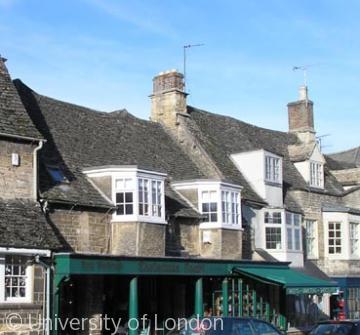High Street (west): Nos 92-94

At No. 94, now called Christmas Court, the canopy with supporting columns, the boxed shopfront, and the bay windows are all 19th-century. Possibly they were added when part of the building was a hairdresser's (1850s–1910s or later). The central passageway may have also been cut through during the 19th century, and gave access to a blacksmith's forge at the rear: blacksmiths were recorded on part of the premises by the 1850s, and continued until the 1910s or 1920s. By the 1950s–60s the whole site belonged to Charles Pether's builders, the rear outbuildings becoming works and offices, and the front a store and retail shop. The premises were redeveloped in the 1980s by Aubrey Newman, and the shopfronts in the passage are now all late 20th-century.
The main building itself is considerably earlier. The low roof-line suggests an early date, and in the right-hand shop, on the ground floor, is part of a doorway with ball-flower decoration, typical of the late 14th century. The roof has upper crucks, and may also be early. The blocked archway to the left of the stone front was an early 16th-century doorway, and in the 17th century the building was modernized with a new staircase and mullion windows, which can be seen from the central yard. The doorway to the right-hand shop is also 17th-century, and two small windows, now blocked, can be seen beside the bay windows to the first floor facing the street.
No. 92, on the right (or north), began as a narrow, 16th-century timber-framed building on the corner of the larger plot occupied by No. 94. Its stone cellar is medieval, and was perhaps for storage. The stonework of the adjacent building extends over the façade, suggesting that the properties were once united. A 17th-century fireplace survives on the ground floor, but the shopfront under a slated lean-to roof, the dormer, and the first-floor bay window were added in the 19th century, when the building was successively occupied by a confectioner, baker, and wine and tea merchant (1840s–70s), a carpenter and wheelwright (1880s), and a printer (1901). A rear outbuilding has a 17th-century fireplace, but may have been a bakehouse or kitchen.
(Photo by Jessica Brod, Oxfordshire Buildings Record)
Content generated during research for the paperback book 'Burford: Buildings and People in a Cotswold Town' (ISBN 13 : 9781860774881) for the England's Past for Everyone series


